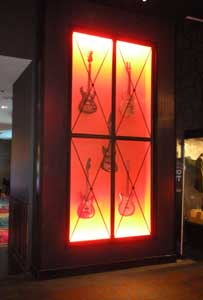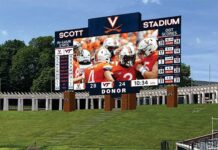With each advance in LED technology, these lighting components are illuminating more and more new signage—many for the retrofits of older signs that were incorporating fluorescent or neon lighting.
Opportunities are only limited by the range of LED products, and suppliers have made strides in developing solutions for a range of signage applications.
In fact, LEDs can be presented to clients as an option in most settings that require lighting: channel letters; sign cabinets and light boxes; window displays; awnings, soffits, and canopies; building outlines and accents; wall washes; cove lighting; and more creative signage.
According to Mark Shepard, global signage product manager for LEDs at GE Lighting, the appeal of LEDs in new signage closely parallels the reasons that make them such a popular retrofit solution.
“LEDs are very energy-efficient when compared with other types of lighting sources,” he points out. “They also have a long life, when compared to other types of lighting.
“And that means less maintenance over the life of that sign.”
For end-users, that lack of maintenance is one of the great advantages of LEDs. “Those signs won’t have to be serviced as much, so they will save on service costs,” says Mark Abernathy, director of sales for US LED.
In addition, Mike Bluhm, national sales director for manufacturer SloanLED, says, “People don’t always realize that every time you have to open up a sign to repair or maintain it, you’re wearing it out. With the long life of LEDs, there’s less service required and that’s going to mean longer-lasting signage.”
To successfully sell these solutions though, the sign shop has to be prepared to meet a client’s most likely objection: the initial cost of an LED lighting system, compared with other options.
Although the price of LED components has dropped, an LED system can still add 20 percent or more to the cost of a new sign project when compared with traditional lighting. But any resistance can be dismissed by showing customers how savings on energy alone will pay for the sign in as little as two years.
And that’s really only part of the overall picture.

LEDs can also benefit those who design, build, and install all types of new signage—in particular the ease of design and implementation, combined with fast completion time.
“On new builds, the payback from LEDs can be even quicker than with a retrofit,” says Bluhm. “We’re finding more sign shops are using them in their new high-rise signage that’s hard to get to.”
Today’s systems also take up less space and require fewer components, allowing for more efficient and space-saving designs. “From a cabinet perspective, as much as 85 to 90 percent of new builds are using LEDs,” says Shepard.
Abernathy says, “I’ve noticed an overall trend of signage solutions getting shallower, as well, thanks to LEDs.”
As for other design trends, Shepard says lighting style can be very individual, especially when it comes to cove and border lighting. “Obviously things like casinos are much different as opposed to the banking industry or the retail industry, which tend to be a little bit more conservative,” he says.
Shepard goes on to say that LEDs for cove and border lighting are being used both inside and out. “It’s a novel way to light the interior of a building,” he says. “We’re seeing it a lot on lighting the exterior of the buildings too, particularly with gasoline stations; they like to run border lighting around their canopy and also on the buildings themselves.”
The low-voltage requirements of LEDs are also giving sign builders new options. Abernathy cites illuminated pole signs. “Because LEDs are lower voltage, you can use lower gauge wiring, and the power supply and drop panel can be as much as 200 feet away from the sign itself, in a way that’s much more accessible,” he says.
So when there is a need to service the power supply, it can be easily reached by ladder or even at ground level. “You don’t have to worry about the expense of renting a crane for even routine maintenance,” says Abernathy.
Shepard adds, “When you use LEDs, you don’t need a bunch of internal structure and conduit to support the lighting. Most LED systems require class II power supplies and tend to be much easier to install, when compared with fluorescent and neon lighting.”
Installation, everyone agrees, is relatively simple. “Installation of LEDs is pretty straightforward and simple, if you follow the instructions,” says Mark Harris, national sales manager for Light Source Solutions (www.lssled.com), noting that, instead of splicing wires, some systems just require crimping a clip and moving on.

In fact, the ease of installation can be a hidden benefit of working with LEDs as it frees up time for other clients and projects.
“I think we’re really in the beginning of the adoption of LEDs for all kinds of new sign applications,” says Bluhm.
Shepard agrees. He sees LEDs expanding beyond retrofits into all-new areas. “The sky is the limit,” he says. “It could be something that no one has ever thought to light up before.”
“Selling LEDs is a great way to promote your business and provide your customer with good, quality products,” says Abernathy.
By Ashley Bray
Photos (Top to Bottom): GE Lighting, Dave Forrest, Dave Forrest.











